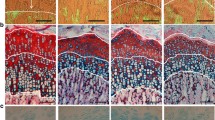Summary
Previous studies have reported that potassium depletion arrests both body and heart growth, and that aortic ligation can induce myocardial potassium loss. To examine the effects of potassium depletion on the cardiac growth response to an increase in pressure load, we induced severe potassium depletion in rats by dietary means for 3 weeks and then subjected them to aortic ligation. 3 weeks following ligation and after a total of 6 weeks of continued potassium deprivation, the animals were sacrificed. Our results show that after aortic ligation the left ventricular weight in potassium depleted rats significantly increased by an average of 155 mg, a value which was somewhat less than the 208-mg increase observed in normokalemic animals. The presence of focal myocardial necrosis in hypokalemic rats, accordingly, did not appear to prevent the increase in ventricular mass induced by augmented pressure load. Furthermore, despite marked reduction in skeletal muscle potassium content there was no decrease in the myocardial potassium content even after aortic ligation. We conclude that profound dietary potassium depletion for a prolonged period of 6 weeks does not impede the cardiac growth response to an increase in pressure load.
Zusammenfassung
Nach früheren Untersuchungen soll eine Kaliumverarmung des Organismus das Wachstum von Körper und Herz zum Stillstand bringen; andererseits soll eine Ligatur der Aorta zu einem Kaliumverlust des Myokards führen. Um zu untersuchen, wie Kaliumverarmung die Antwort des Herzens auf eine Druckbelastung beeinflußt, wurde bei Ratten ein schwerer Kaliumverlust durch dreiwöchige Diät erzeugt und anschließend eine Aortenligatur gelegt. Drei Wochen nach Anlegen der Aortenstenose und insgesamt sechs Wochen nach Beginn einer ununterbrochen fortgesetzten Kaliummangeldiät wurden die Tiere untersucht. Die Ergebnisse zeigen, daß nach Aortenligatur das linksventrikuläre Gewicht kaliumverarmter Tiere signifikant um durchschnittlich 155 mg zunimmt. Dieser Wert ist etwas geringer als der für normokalämische Tiere (208 mg). Ein Auftreten fokaler Myokardnekrosen in hypokalämischen Ratten schien keinen Effekt auf die druck-induzierte Zunahme der Ventrikelmasse zu haben. Trotz erheblicher Reduktion des Kaliumgehaltes im Skelettmuskel war keine Abnahme des myokardialen Kaliumgehaltes zu verzeichnen. Wir folgern daraus, daß ein ausgeprägter, diätetisch erzeugter Kaliummangel innerhalb von sechs Wochen das Wachstum des Herzens als Antwort auf eine vermehrte Druckbelastung nicht zu verhindern vermag.
Similar content being viewed by others
References
Kao, R. L., D. E. Rannels, V. Whitman, H. E. Morgan: Factors Accounting for Growth and Atrophy of Heart. In: Recent Advances in Studies on Cardiac Structure and Metabolism, vol. 12, edited by T. Kobayashi, Y. Ito and G. Rona. University Park Press (Baltimore 1978).
Fernandez, L. A., S. E. Dorring: Cardiomyopathy produced in rats with acute renal hypertension. J. Lab. Clin. Med.95, 159 (1980).
Nair, K. G., A. F. Cutilletta, R. Zak, T. Koide, M. Rabinowitz: Biochemical correlates of cardiac hypertrophy. I. Experimental model: changes in heart weight, RNA content, and nuclear RNA polymerase activity. Circulat. Res.23, 451 (1968).
Schrader, G. A., C. O. Prickett, W. D. Salmon: Symptomatology and pathology of potassium and magnesium deficiencies in the rat. J. Nutr.14, 85 (1937).
Cuisinier-Gleizes, P., H. Mathieu, G. Witmer, H. Dulac, S. Herouard, R. Habib, J. Lefebvre, P. Royer: Effects de la carence potassique chez le rat sur le squelette, le cholestérol plasmatique, l'histologie des surrénales. Pathol. Biol.12, 1055 (1964).
Evan, A., J. Huser, H. H. Bengele, E. A. Alexander: The effect of alterations in dietary potassium on collecting system morphology in the rat. Lab. Invest.42, 668 (1980).
Levine, D. Z., T. Walker, L. A. Nash: Effects of KCl infusions on proximal tubular function in normal and potassium-depleted rats. Kidney Internat.4, 318 (1973).
Levine, D. Z., K. Sarkar: Effects on tissue and electrolytes of a mineralocorticoid blocker during DOCA-induced potassium depletion. Can. J. Physiol. Pharmacol.54, 59 (1976).
Beznak, M.: The behaviour of the weight of the heart and the blood pressure of albino rats under different conditions. J. Physiol.124, 44 (1954).
Hjalmarson, A. C., D. E. Rannels, R. Kao, H. E. Morgan: Effects of hypophysectomy, growth hormone and thyroxine on protein turnover in heart. J. Biol. Chem.250, 4556 (1975).
Lubin, M.: Intracellular potassium and macromolecular synthesis in mammalian cells. Nature213, 415 (1967).
Ledbetter, M. L. S., M. Lubin: Control of protein synthesis in human fibroblasts by intracellular potassium. Exp. Cell Res.105, 223 (1977).
Author information
Authors and Affiliations
Rights and permissions
About this article
Cite this article
Levine, D.Z., Sarkar, K., Nash, L. et al. The influence of potassium depletion on cardiac growth response to pressure overload. Basic Res Cardiol 78, 53–61 (1983). https://doi.org/10.1007/BF01923193
Received:
Issue Date:
DOI: https://doi.org/10.1007/BF01923193




